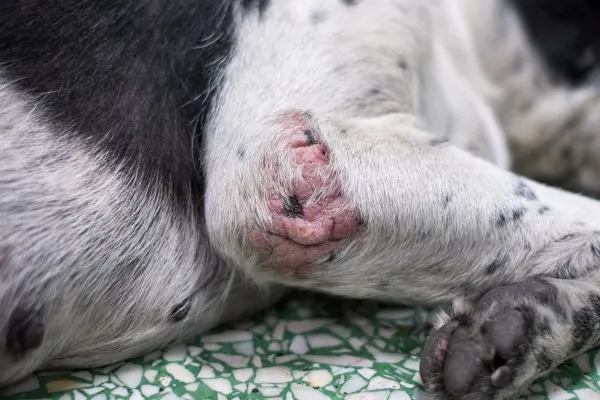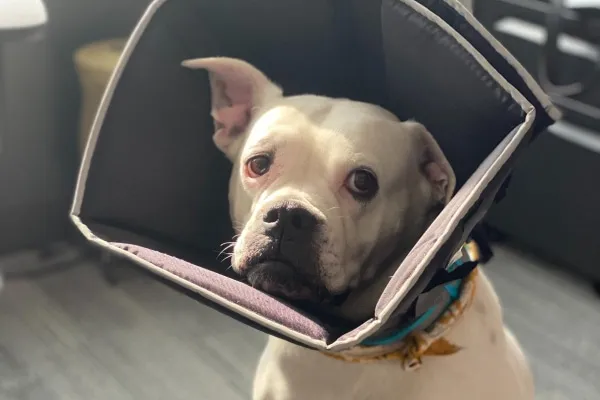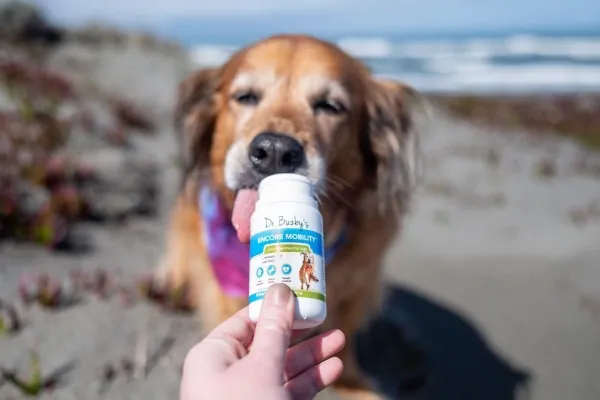One of the most concerning challenges for dog owners, particularly those caring for senior pets or dogs with limited mobility, is the development of pressure sores. These painful skin lesions, often referred to as bed sores or decubitus ulcers, are a valid concern, similar to those seen in human hospice care. Thankfully, while daunting, pressure sores in dogs are treatable, and more importantly, largely preventable with the right knowledge and proactive care. This comprehensive guide will delve into what pressure sores are, why they occur, how to recognize them, and most critically, how to effectively heal pressure sores on dogs while preventing their recurrence.
What Are Pressure Sores on Dogs? (Decubitus Ulcers)
Pressure sores, medically known as decubitus ulcers or decubital ulcers, are chronic skin injuries that result from sustained pressure on the skin, typically over bony prominences. These lesions form when a dog’s body weight consistently presses down on an area where bone is close to the surface of the skin, such as the elbows, hocks, hips, or shoulders. This constant pressure restricts blood flow and oxygen supply to the skin cells in that area. If the pressure isn’t relieved by frequent repositioning, the deprived skin tissue begins to die, leading to irritation, inflammation, and eventually an open wound—a pressure sore. While less common, pressure sores can also be caused by ill-fitting casts, splints, or bandages, though our focus here is on those caused by prolonged recumbency.
 Visually identifying a decubitus ulcer on a dog's elbow, an early sign of canine pressure sores
Visually identifying a decubitus ulcer on a dog's elbow, an early sign of canine pressure sores
Which Dogs Are Prone to Developing Pressure Sores?
Any dog that spends extended periods lying down, particularly on hard surfaces, is at risk of developing these debilitating skin ulcers. However, certain factors and health conditions significantly increase a dog’s susceptibility:
Senior Dogs
As dogs age, they often experience a natural loss of muscle mass, a condition known as sarcopenia. This reduction in muscle and fat padding around bony areas means there’s less cushioning to protect the skin from pressure, making senior dogs more vulnerable. Their decreased activity levels also contribute to longer periods in one position.
Post-Surgery or Ill Dogs
Dogs recovering from surgery or a severe illness may be unable or unwilling to move frequently due to pain, weakness, or sedation. Their immobility makes them prone to staying in a single position for prolonged periods, increasing the risk of pressure sore formation.
Paralyzed Dogs
Conditions causing paralysis, such as intervertebral disc disease (IVDD) in dogs, spinal stroke in dogs, or other neurological disorders, render dogs unable to effectively reposition themselves. This constant pressure on specific points is a prime cause of decubitus ulcers.
Large Breed Dogs
The sheer body weight of larger breeds puts greater pressure on their bony prominences when they lie down. This increased force can more rapidly compromise blood flow to the skin, even with moderate immobility.
Dogs with Orthopedic Issues
Dogs suffering from painful orthopedic conditions like osteoarthritis in dogs, hip dysplasia in dogs, or other joint diseases may be reluctant to change positions due to discomfort. They might favor one particular lying position, inadvertently putting chronic pressure on certain areas.
Understanding the Causes of Pressure Sores in Dogs
The underlying cause for all these susceptible dogs boils down to one critical factor: increased pressure on a specific area of skin for an extended duration. Immobility, or even just reduced mobility, combined with contact with a firm surface, creates the perfect storm for pressure sore development.
When your dog lies down, bony parts of their body—such as the elbows, hocks (ankles), hips, sternum (chest bone), pelvis, and the sides of the legs—make direct contact with the ground. These areas naturally have minimal cushioning (muscle or fat) over the hard bone. The skin caught between the bone and the hard surface becomes compressed, effectively cutting off its vital oxygen and blood supply.
For an active dog, frequently getting up and changing positions ensures that no single area is under pressure for too long, allowing normal blood flow to resume. However, for dogs with limited mobility, this essential repositioning doesn’t happen often enough. Without a continuous supply of oxygen and nutrients, the skin cells begin to suffer and eventually die. This compromised skin becomes highly susceptible to further irritation, friction, moisture, and bacterial infection, ultimately leading to the formation of a painful pressure ulcer.
How Do Pressure Sores on Dogs Look? Recognizing the Signs
The appearance of a pressure sore varies depending on its stage of development. Early detection is crucial for successful healing and prevention of progression.
Early Symptoms of Canine Pressure Sores
In the initial stages, pressure sores might be subtle and easily mistaken for other skin issues or even normal calluses. Keep an eye out for:
- Patches of hair loss: Often observed around bony areas like the elbows, hocks, or hips.
- Reddened skin: The affected area may appear pink or red, indicating inflammation.
- Dryness and cracking: The skin might become dry, flaky, and potentially crack, making it more vulnerable.
- Constant licking or chewing: Dogs often lick the irritated area excessively, which can further exacerbate the problem and sometimes lead to a lick granuloma in dogs.
- Pain or discomfort: Your dog may show signs of pain when the area is touched.
- Thickening of the skin: Similar to an elbow callus in dogs, the skin may become tougher and thicker as a protective response.
If you notice any of these early warning signs, it is imperative to consult your veterinarian promptly. Early intervention can significantly ease treatment and prevent the sore from becoming a severe, open wound.
Advanced or Infected Pressure Sore Symptoms
If an early-stage pressure sore is not addressed, or if it becomes infected, the symptoms will worsen and become more apparent:
- Open wound: A visible open lesion or ulceration will form, exposing underlying tissue.
- Skin discoloration: The skin around the sore may appear bright red, purple, or even black, indicating severe tissue damage or necrosis.
- Swelling or raised skin: The area immediately surrounding the sore may be swollen or raised.
- Moisture or drainage: The wound might ooze clear, yellowish, or reddish fluid, which can stain the surrounding fur.
- Pus or yellow discharge: A clear sign of bacterial infection, often accompanied by a foul odor.
- Crusty debris: Scabs or crusts may form on or around the wound.
- Increased signs of pain: Your dog may exhibit more pronounced pain behaviors such as whining, reluctance to move, changes in appetite, or aggression when the area is approached.
These advanced symptoms warrant immediate veterinary attention. An infected pressure sore is not only incredibly painful for your dog but can also lead to widespread infection (sepsis) if left untreated.
Diagnosing Pressure Sores: What to Expect at the Vet
When you bring your dog to the veterinarian with suspected pressure sores, the diagnostic process typically begins with a thorough physical examination. Your vet will carefully inspect your dog’s skin, paying close attention to any visible lesions, particularly over bony prominences like the elbows, hocks, hips, sternum, and sides of the legs. This allows the vet to assess the severity and extent of existing sores and to identify any early-stage lesions you might have missed.
Veterinarians often use a staging system, similar to the National Pressure Ulcer Advisory Panel (NPUAP) scoring chart used in human medicine, to classify the severity of each pressure ulcer. This staging helps guide treatment decisions and track progress.
If an infection is suspected, your vet may recommend additional diagnostic tests:
- Cytology: A cotton swab is used to collect samples from the wound, which are then examined under a microscope to identify bacteria, white blood cells, and other cellular material indicative of infection.
- Culture and sensitivity testing: This test involves sending a sample to a lab to identify the specific type of bacteria causing the infection and to determine which antibiotics will be most effective against it.
- Blood tests: Blood tests for dogs may be performed to check for signs of systemic infection (e.g., elevated white blood cell count) or to assess your dog’s overall health.
Taking photographs of the ulcers during initial and subsequent visits is also a valuable tool for both you and your vet to monitor the healing process over time.
Comprehensive Treatment for Pressure Sores on Dogs
Once diagnosed, your veterinarian will develop a tailored treatment plan to heal the pressure sore. It’s crucial to understand that simply treating the sore itself is often insufficient; the underlying factors contributing to its development must also be addressed. Otherwise, the sores are likely to recur or fail to heal completely. The primary goal is to alleviate pressure on the affected areas.
 A Boxer dog wearing an Elizabethan collar to prevent licking and aid in healing a pressure sore
A Boxer dog wearing an Elizabethan collar to prevent licking and aid in healing a pressure sore
Addressing the Root Cause: Pressure Relief is Key
The most fundamental aspect of healing and preventing pressure sores is to eliminate the sustained pressure on the vulnerable skin. This often requires a multifaceted approach involving environmental adjustments, mobility support, and diligent home care.
Six Pillars of Pressure Sore Treatment & Prevention at Home
During the healing process and beyond, these six measures are vital for both treatment and proactive prevention:
Repositioning Dogs Frequently: For dogs unable or unwilling to move on their own, manual repositioning is paramount. Aim to gently shift your dog’s position every two to three hours, or even more frequently, around the clock. This ensures that no single area of the body bears continuous pressure for too long, allowing blood flow to restore.
Providing Soft, Orthopedic Bedding: Upgrade your dog’s sleeping arrangements. Encourage them to lie on a high-quality orthopedic dog bed, such as those made from memory foam or egg-crate foam. The key is thick cushioning that conforms to your dog’s body, distributing weight evenly and minimizing pressure points. Ensure blankets or pads used are smooth and wrinkle-free, as wrinkles can create additional pressure. If your dog uses a dog stroller or dog wagon, make sure it is also well-padded.
Utilizing Pressure-Relieving Devices (Wedges, Donuts): Soft foam wedges, blocks, or even specially designed donut cushions can be strategically placed to offload pressure from affected areas. For instance, a foam square can be placed between the hocks to prevent them from pressing against each other, or a wedge can be positioned under the bedding to gently roll your dog slightly off a particular pressure point. Always consult your vet for guidance on the proper placement and use of these devices.
Maintaining Clean and Dry Skin: Meticulous hygiene is critical. Every time you reposition your dog, check their bedding and fur for urine or feces. Soiled skin, especially if damp, is highly prone to irritation, bacterial infection, and the formation of pressure sores or exacerbation of existing ones. Clean any soiled areas immediately with a gentle pet-safe cleanser and ensure the skin is completely dry. If your dog struggles with incontinence, consider using absorbent, wicking pads under their hindquarters to keep urine away from the skin, preventing urine scald in dogs. Discuss any signs of urinary incontinence in older dogs with your vet.
Boosting Mobility and Encouraging Movement: Under your veterinarian’s guidance, explore options to improve your dog’s mobility, even if minimal. This could include:
- Physical therapy exercises: Gentle range-of-motion exercises.
- Hydrotherapy: Water-based therapy to strengthen muscles without impact.
- Mobility aids: Harnesses, slings, or carts to assist walking.
- Joint supplements: Such as glucosamine, chondroitin, or omega-3 fatty acids, to support joint health and comfort.
- Pain management: Ensuring any underlying pain is well-controlled will encourage more natural movement.
 A Golden Retriever interacting with a joint supplement bottle, highlighting the role of mobility aids in preventing and healing dog pressure sores
A Golden Retriever interacting with a joint supplement bottle, highlighting the role of mobility aids in preventing and healing dog pressure soresOptimizing Canine Nutrition for Healing: A well-balanced diet rich in high-quality protein is essential for tissue repair and overall healing. Ensure your dog is receiving adequate calories and nutrients. If your dog has difficulty getting up to eat, bring the food and water bowls directly to them to ensure consistent intake. Nutritional supplements specifically formulated for skin health (e.g., zinc, vitamin E, omega fatty acids) may also be recommended by your vet.
Specific Veterinary Treatments for Pressure Sores
Beyond the essential pressure management strategies, specific medical interventions may be required, depending on the sore’s severity.
- Early Stage Management: For very early-stage pressure sores, your vet might focus primarily on the pressure-relief and hygiene measures outlined above. Specific topical treatments may not be necessary at this point, as prevention of progression is the main goal.
- Treating Infected or Severe Pressure Sores:
- Antibiotics: If the sore is infected, oral and/or topical antibiotics will be prescribed based on culture and sensitivity results to target the specific bacteria.
- Topical Ointments and Creams: Various medicated ointments or creams may be applied to protect the skin, reduce inflammation, moisturize, and promote wound healing. These often contain antibacterial agents, anti-inflammatory compounds, or ingredients that support skin regeneration.
- Wound Dressings/Bandaging: Special wound care dressings can protect the sore from contamination, maintain a moist healing environment, and absorb exudates. However, bandaging can be challenging on certain locations like the elbows or hocks.
- The Role of E-Collars and Wound Debridement:
- E-Collar (Cone of Shame): If your dog is licking, chewing, or otherwise irritating the pressure sore, an Elizabethan collar or inflatable neck ring will be essential to prevent self-trauma, which can significantly impede healing or introduce further infection.
- Surgical Debridement: For deep or severely necrotic (dead tissue) wounds, surgical debridement may be necessary. This procedure involves carefully removing all dead or unhealthy tissue to create a clean wound bed that can properly heal.
- Skin Grafts: In very severe cases where underlying bone, tendons, or ligaments are exposed, or with extensive tissue loss, a skin or muscle graft may be required to cover the defect and facilitate healing.
Outlook for Dogs with Pressure Sores: Healing and Long-Term Management
The good news is that most pressure sores can eventually heal, especially with prompt and consistent treatment. However, it’s important for dog owners to understand that the healing process can be lengthy and requires significant dedication, patience, and financial commitment.
Successful resolution heavily relies on the dog parent’s ability to diligently implement the veterinarian’s recommendations at home. Without consistent pressure relief, meticulous hygiene, and appropriate wound care, pressure sores can be very challenging to resolve and are highly prone to recurrence. Even after healing, continuous preventive measures are crucial to avoid future sores.
Preventing Pressure Sores: Proactive Measures for Your Dog’s Skin Health
Prevention truly is the best medicine when it comes to pressure sores. By proactively addressing the risk factors, you can significantly reduce the likelihood of your dog developing these painful lesions. The preventive strategies mirror the at-home treatment measures:
- Repositioning down dogs frequently: Especially for those with limited mobility.
- Providing soft bedding options: Orthopedic beds are a worthwhile investment.
- Using pressure-relieving wedges, blocks, or donuts: Strategically placed to offload pressure.
- Keeping your dog’s skin clean and dry: Vigilant hygiene, particularly for incontinent dogs.
- Boosting your dog’s mobility to encourage movement: Through exercise, physical therapy, and joint support.
- Paying attention to your dog’s nutrition: A high-quality diet supports overall health and skin integrity.
Daily Skin Monitoring
Make it a habit to inspect your dog’s skin daily, or each time you reposition them. Pay particular attention to the areas most susceptible to pressure sores: elbows, hocks, hips, sternum (breastbone), and the sides of the legs. Gently part thick fur to get a clear view of the skin. Look for any warmth, redness, hair loss, dry patches, or tender spots.
Partnering with Your Veterinarian for a Prevention Plan
If your dog has any risk factors for pressure sores, work closely with your veterinarian to create a personalized preventive care plan. Your vet can assess your dog’s specific mobility limitations, current environment, pain levels, and other contributing health factors to develop a practical and effective strategy tailored to your dog’s needs.
While diligent prevention significantly reduces risk, some dogs may still develop pressure sores despite the best efforts. This underscores the importance of daily skin checks. The sooner you identify a potential problem and contact your vet, the quicker you can adjust your care plan and initiate treatment, ultimately keeping your beloved canine companion as happy and comfortable as possible.

 A Golden Retriever interacting with a joint supplement bottle, highlighting the role of mobility aids in preventing and healing dog pressure sores
A Golden Retriever interacting with a joint supplement bottle, highlighting the role of mobility aids in preventing and healing dog pressure sores